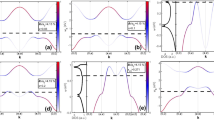Abstract
The wave-function envelope method is used to describe the electronic states of the cuprate high-T c superconductors (HTSCs). In this method the 2D electronic states of the CuO2 layers of a unit cell play the role of quantum wells, while the 2D states of the reservoir play the role of quantum barriers. Because of the different anisotropy of the 2D effective masses of the wells and barriers, some states on the Fermi surface (line) belong to CuO2 layers and some states belong to the reservoir layers. This behavior of the electronic states explains characteristic features of HTSCs, such as the existence of regions on the Fermi surface with strongly different relaxation times, the weak suppression of d-type superconducting pairing by nonmagnetic scattering, and the coincidence of the angular dependence of the superconducting order parameter and the angular dependence of the electronic density of states (forward scattering predominating). The change in the signs of the components of the effective masses along the Fermi surface can result in the formation of hole pairs (biholes) or electron pairs (bielectrons) on account of the Coulomb interaction in the case of a negative reduced mass of the pairs.
Similar content being viewed by others
References
I. Bozovic and J. N. Eckstein, in Physical Properties of High Temperature Superconductor, Vol. V, edited by D. M. Ginsberg, World Scientific, Singapore 1996.
R. Combescot, Phys. Rev. B 57, 8632 (1998).
M. Sugihara, M. A. Ikeda, and P. Entel, Phys. Rev. B 57, 11760 (1998).
V. V. Kapaev and Yu. V. Kopaev, JETP Lett. 65, 202 (1997).
A. A. Abrikosov, Phys. Rev. B 57, 7488 (1998).
E. F. Gross, I. N. Ural’tsev, and R. I. Shekhmamet’ev, JETP Lett. 13, 357 (1971).
A. Zheleznyak, V. Yakovenko, H. Drew, and I. Mazin, Phys. Rev. B 57, 3089 (1998).
G. Varelogiannis, Phys. Rev. B 57, R732 (1998).
Author information
Authors and Affiliations
Additional information
Pis’ma Zh. Éksp. Teor. Fiz. 68, No. 3, 211–216 (10 August 1998)




